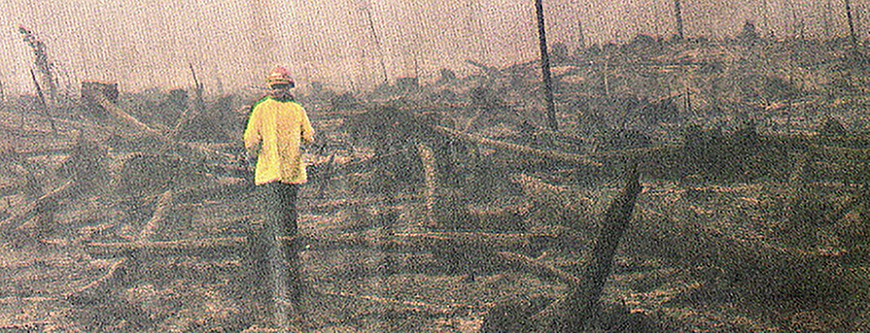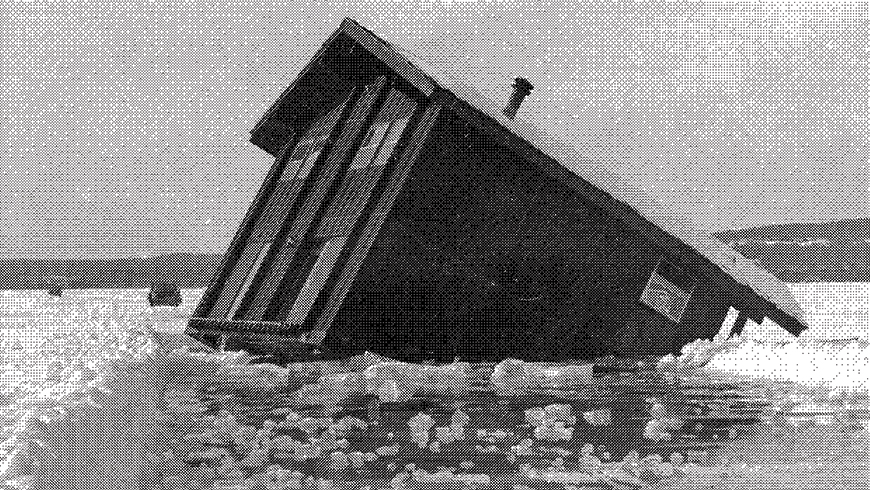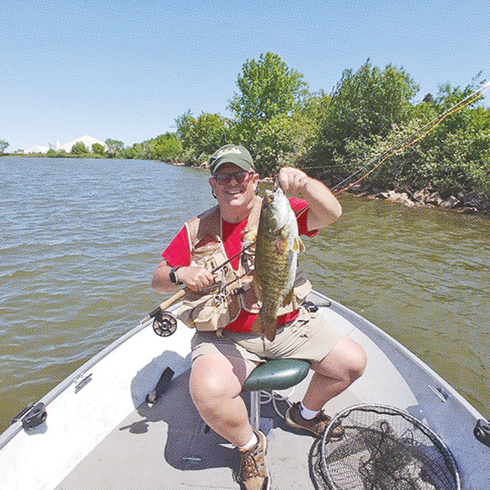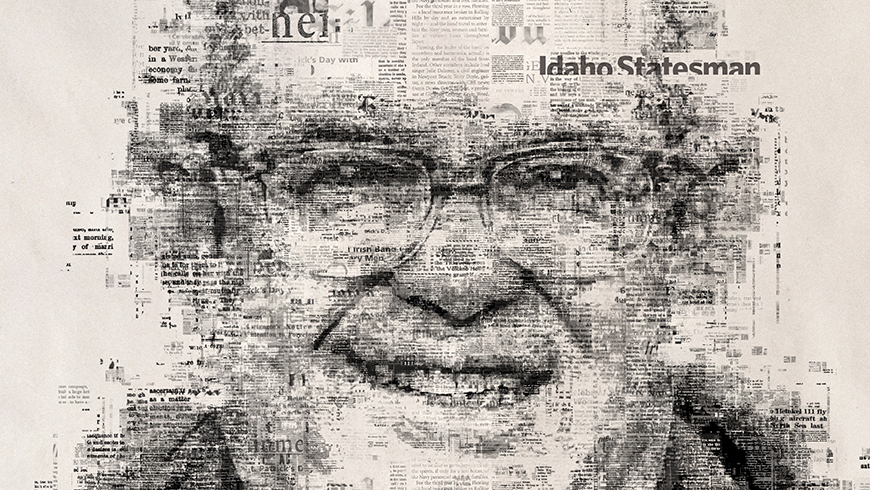The sudden gust of wind pressed against Rocky Barker’s back, the first hint of the coming conflagration.
He’d spent weeks covering the wildfires raging through Yellowstone National Park. Each day, he and a handful of reporters listened in on briefings at the incident command center, digesting the changing firefighting strategies and chasing the biggest fires and stories.
As usual, Barker was behind the fire line. His editor, Bill Hathaway, at the Idaho Falls Post Register, had ordered Barker not to come within a quarter mile of the fire. As usual, Barker hand-waved that instruction, as he’d done minutes before when a park ranger ran through the Old Faithful parking lot, screaming at the people gathered there, “Run for your lives! If you don’t get out now, you’re dead!”

Yellowstone National Park, August 23, 1988. Photo by Rocky Barker.
It was 1988, and Barker says he’d already seen more wildfire than most professional fire crews.
He understood fire behavior. The ranger was overreacting.
Or maybe not. Detritus was blowing straight toward Barker and the fire crew he’d followed. A reporter grabbed Barker’s arm. “We gotta go,” he said. “Now.”
A low rumble turned into a roar. The day
went dark.
Barker wasn’t supposed to be at Yellowstone. He’d been happily hiking in Montana with his wife, Tina, and three children, when the park caught fire. Barker couldn’t take it after a few days. His beats and his loves—the environment and the West—were calling. He had to answer. His wife was upset. Barker was putting work ahead of family. Again. She said to stay with the family, to enjoy his time off, to do the smart thing for once.
Her words were as successful as Hathaway’s. She was going to be bereft if Barker died in that fire. She was also going to be pissed.
The blast of wind that ripped through the forest reached 80 miles per hour, Barker now guesses, bringing the maelstrom. Firebrands the size of fists screamed past his head as he and the firefighters sprinted through the woods. Reporter notes stuffed in Barker’s yellow Nomex jacket flew out, soon to be fuel for the coming flames. He kept running.
Barker and the others cleared the 100 yards into the Old Faithful parking lot as the furious fire devoured the woods they’d exited. Barker drove to West Yellowstone, wrote his article, phoned it into the newsroom and returned to the fire line the next day.
If you know Barker, you’ve probably already heard that story one time, or perhaps five times. (Disclosure: I worked with Barker at the Idaho Statesman for five years.) He’s a talker, and the ’88 Yellowstone Fire story is one of the many crowd pleasers he’s lived and perfected over 43 years of newspaper reporting. Barker spent 33 of those years in Idaho, covering the crucial environmental and natural resource developments that shaped the state and the West, including public land access, water rights, wildlife preservation and, of course, wildfire management.
Barker retired in May after 22 years at the Idaho Statesman, thus ending a career spanning more than 5,000 articles, a movie script, four books and more than a few exhausted editors. He’s won dozens of awards, including a finalist nomination for a Pulitzer as part of a Statesman team that covered the scandal stemming from then-Sen. Larry Craig’s toe-tapping incident in a Minneapolis-St. Paul Airport bathroom in 2007.
“It’s not that I’m great. It’s that I’m a little obsessive. If I had to do it on my own time, I did. If I had to work around the clock, I did. I finally found a place at the Idaho Statesman where the editor realized, ‘We have this crazy guy who drives everybody nuts, who doesn’t do what he’s told, but who is willing to put himself in front of a fire. We’ll enable that.’” — Rocky Barker
Barker’s articles and hundreds of his well-known “Letters from the West” columns shaped the public’s appreciation for important issues. He is, without question, the foremost Idaho media expert on all things related to how Idahoans use land for business and pleasure. Few newspapers have regional expertise in any subject. Few newspapers even have environmental reporters anymore. But Barker made a four-decade career out of outdoors coverage because he was too good to be pulled from the beat and too stubborn to let anybody divert him from his path.
Barker’s source list includes hundreds of politicians, lobbyists and conservationists he’s known for decades. One of those is Tom France, regional director of the National Wildlife Federation based in Missoula, Mont. France and Barker traveled together as part of a group to Africa to observe village-based conservation.
France says he’s fielded calls from reporters for years. Nobody made a career out of understanding the issues like Barker, he says. “He saw an opportunity in covering the environment that nobody else did. People said it couldn’t be done until Rocky showed up and did it. There’s not an environmental journalist with his résumé anywhere in the West.”
Barker held absolute conviction in what he believed was and wasn’t newsworthy, making him a handful for editors, longtime Statesman editor Bill Manny says. But Barker’s foibles were the flipside of the strengths that made him successful. It all informed the instincts that drove him to get the story and to get it right.
After some time, Manny says Barker learned to trust Manny’s judgment and allegiance to storytelling. Manny says some of Barker’s most nuanced reporting, such as telling the story of the lives and deaths of wolves and grizzlies since their reintroduction to the Idaho wild, were “stories that few journalists in Idaho or elsewhere would have tried to pull off,” he says.
“For many reporters, journalism is a job, done well and professionally, but still a job,” Manny adds. “For some, it’s also a calling. For reporters like Barker, it’s their life, their work, their recreation, their reason
for being.”
Early Inspirations
Barker bounced between two towns in Illinois, outside of Chicago, while growing up. He trapped small game and idolized history’s mountain men voyagers. He says he claimed the last bounty for foxes in 1969 and the last coyote reward in Wisconsin in 1973.
Barker later fell in love with hunting and fishing, cementing his conservation ethic.
He read the newspaper each morning and devoured stories about a sort of environmentalist Robin Hood—some today would say “eco terrorist”—who called himself “The Fox.” The Fox plugged a soap factory’s pipes that discharged pollution into the river. He capped the smokestack of an aluminum manufacturer. He broke into U.S. Steel headquarters in Chicago and dumped hazardous waste on the CEOs carpet. The Fox was a hero to Barker. His appreciation deepened years later when Barker learned the identity of the activist, who’d become an environmental regulator in Illinois after the first environmental protection laws with any teeth went into effect.
Barker chose to attend Northland College in northern Wisconsin after the school sent him a brochure with photos of people hunting and canoeing on Lake Superior. He became active in the school’s new Sigurd Olson Environmental Institute, named in honor of a writer and preservationist credited with saving the Boundary Waters of Wisconsin. Before long, Barker was hobnobbing at cocktail parties with Olson, politicians and other players in the founding era for conservation.
“Rocky’s curiosity and his professional nose for a story really set himself apart from every other reporter I’ve encountered. he knows issues. He senses when they are developing into a story. We’re good friends now, but I know he has hundreds of good friends and contacts.” — Tom France, National Wildlife Federation
Barker remembers accepting an invitation to a party along with bigwigs on Wisconsin’s Beaver Dam Lake with the likes of lawmakers, professors, and attorneys general. He was on the inside, and he loved it.
“There was a senator, an attorney general, a congressman, all these interesting people,” he says. “Then there’s me, sitting there drinking gin and tonics on this pontoon boat. For a student, then later as a young journalist, this was getting to see behind the curtain. It was the neatest thing in the world.”
During his senior year, Barker and his trapping partner interviewed two old-timer trappers and wrote a column about a lifestyle that was going extinct. His partner did most of the writing. Barker successfully pitched the column to a local sporting magazine, then parlayed that clip into his first journalism job at a small weekly, the Washburn Country Journal, where he wrote and sold ads. Landing the job was an early case of what an editor later described as Barker’s ability to “create his own weather.”
“That column was the only journalism I’d ever done,” he says. “I graduated from college and largely couldn’t write. My daughter wrote much better when she graduated from high school.”

The sinking house, Lake Superior, off the shore of Madeline Island, March 2, 1977. Photo by Rocky Barker.
The Sinking House
Despite covering sports part-time in his first gig, Barker didn’t take long to break the big stories about tribal rights and fights over natural resources, first at the Washburn Times and then at the Rhinelander Daily News, where he quickly ascended to editor of the four-person staff. In that time, he met Tina, a passenger in a vehicle that picked him up as he hitchhiked between small Wisconsin towns in 1976 while he worked at the Times. They married in 1979 and have three children.
Barker’s Greatest Hits of Wisconsin mixtape is too lengthy to detail here, especially given the complexity of the issues. Instead, here’s a summary of the story that gave Barker his first taste of the big time: the sinking house.
It was 1977. A homeowner planned to move a fully furnished, seven-room house four miles across the 3-foot thick ice of Lake Superior from Port
Superior to Madeline Island using a 30-ton truck
and trailer.
The house made it three miles. The house tipped. The ice broke. The house and truck slowly sank.
Barker had driven to the scene in his Volkswagen Bug. He snapped photos, wrapped up his reporting, then sped back to the newsroom where he yelled, “Hold the presses!”
The paper did, buying time to develop and publish what is now an iconic photo in the region of the house slipping into the deep water.
Barker jumped on the phone and called photo editors for major papers in the region, promising them “the best photo you’ve seen in your life.” The Chicago Tribune and Minneapolis Tribune both bit. Barker shipped them the photo via bus. The Chicago paper gave it a half page of space on the back of a section. The Minneapolis paper gave it a half-page of real estate on a section front. Wire services picked up the photo, which soon ran in papers in Los Angeles, Miami, Tel Aviv and countless others in between. It later ran in the Associated Press’ annual book celebrating its photos of the year. Barker remembers selling the photo for $200 to the Chicago Tribune, $85 to the Minneapolis Tribune, $35 to the Associated Press and $25 to UPI.
Barker has never shied away from the limelight. That taste was all it took.
“It was the adrenaline of that day,” he says. “That’s why I’m a journalist.”
Barker Moves West
Barker applied for the environmental reporter position in Idaho Falls in 1985. The editor interviewing Barker asked for a Wisconsin reference who could speak to Barker’s reporting chops. Barker’s response: “Call anybody.”
He got the job.
Thus started a three-decade relationship with the Idaho outdoors and with the myriad experts and politicians that swam in those streams. Many of those sources have had dozens or hundreds of conversations with Barker over the years. Many count him as a friend.
Cecil Andrus, who Barker first covered in Wisconsin as the head of the U.S. Department of the Interior and again as governor of Idaho, impressed upon Barker the need to bring all sides of an issue to the table, Barker says. That meant understanding issues such as salmon preservation from all sides. In Idaho, that means conservation advocates. But it also means understanding energy, agriculture, recreation, flood control and a complex history and system of water rights.
France says that everybody-at-the-table approach was evident in Barker’s stories on salmon and dams. After traveling the state to talk to all of the players, Barker authored a Statesman series that strove to give all of the stakeholders their say. That series led to Statesman editorials advocating for removing four dams on the Lower Snake River in order to protect salmon, a controversial position then and now.
Barker and the Statesman revisited salmon restoration again in 2017, and again Barker listened to all of the players. That was natural to Barker, France says, because he was friends with the industry
lobbyists just like he was with the greener side
of the debate.
“He stuck with it. He did it his way. You have to give him credit for that.”— John Thompson, formerly of the Idaho Farm Bureau
“I think he surprised people in the series last year with the focus he gave to Bonneville Power and how he explained the challenges it faces in the coming years,” France says. “He could have just written about dams and fish, but no. He found an angle that hadn’t been reported and was the first one to do it.”
That’s not to say every source always agreed with Barker. John Thompson, himself a former reporter, was a Barker source for 18 years when Thompson was spokesman of first the Idaho Potato Growers Association and then the Idaho Farm Bureau.
Barker, ever opinionated, lets advocacy bleed into his reporting, Thompson says. One time in particular irked him when Barker contributed to a series about how Idaho’s rural communities were dying. Thompson rejected the series premise, saying it was reporting based on an errant assumption.
“To me, that’s backward,” Thompson says.
“I disagreed fundamentally with their approach and their conclusions.”
But Thompson says he was never misquoted, and he enjoyed bantering with Barker. The reporter was well versed on the issues, and Thompson appreciated that he wanted to talk to the farmers and ranchers affected by them.
“We had our differences, but I want to stress he was always fair,” Thompson says. “He never misquoted me or attacked me in his writing. Most of the time when he was critical of the Farm Bureau, he was right.”
The West Burns
After covering hundreds of fires, Barker’s career will be forever tied to the increase in the number and intensity of wildfires in the West, how the Forest Service shifted its wildfire management strategy and how too many firefighters died.
“Black Saturday” in which 123,000 acres burned in a single day in Yellowstone, was national news in 1988. Such burns are commonplace today, Barker says, in part due to global warming, a trend he started writing about in 2005. A decade prior, the Forest Service fought to save every acre of burning forest. Over time, that philosophy changed, but not in time to prevent tragedies, Barker says.
He still gets emotional when he remembers the Cramer Fire that burned near Salmon in 2003. Two firefighters, Jeff Allen and Shane Heath, were working on top of the Salmon River Breaks with only a steep, fuel-ridden ridge between them and the blaze. The fire swept uphill, as fire does, killing the young men.
“They were just left up there, and they never should have been there in the first place,” Barker says.
Barker thought the authorities were lying about the decisions that led to the fatalities. He says he worked his Salmon sources to discover that there was inexperience and negligence throughout the chain of command during the firefighting effort. After writing the initial article, he and another reporter sunk their teeth into the matter, exposing the mismanagement. The incident commander later faced formal disciplinary actions.
Barker covered dozens more fires and continued chronicling changes in wildfire management policy. His 2005 book, “Scorched Earth,” detailed how the 1988 Yellowstone fire changed wilderness and fire management. The book was adapted into a screenplay for a TV disaster movie, “Firestorm.”
“He knew the issues so well that we could talk about how we got into the mess we were in with these big fires, the policies that got us there, the mistakes some of our agencies made. We could talk about our own cultural fear of fire. — John Freemuth, Boise State University
Barker says wildfire fighting has changed for the better since 13 people died in a 1994 fire. But he’s dismayed that firefighters are still put in harm’s way, like the 19 that died during the Yarnel Hill wildfire in Arizona in 2003.
“I think we made a difference in our reporting in 2003 that showed the mistakes being made,” he says. “I hope nobody ever puts a firefighter in front of a fire in the Salmon River Breaks ever again.”
Legacy
Barker’s retirement leaves a void in how Idahoans understand the events and policies shaping their environment, says another longtime source, Idaho Conservation League Director Rick Johnson. Even if papers hire an environmental reporter, which few do anymore, they won’t be on a first-name basis with every player like Barker. They won’t have an encyclopedic knowledge of the issues and the history of events, people and policies that give context to every discussion.
“I’m an expert in my field, and Rocky Barker has forgotten more about certain parts about Idaho environmental issues than I remember,” Johnson said.
“We had a beer the last time I saw him. I joked that, finally, at the bitter end, I didn’t have to say what was off of the record. He said, ‘No! I still
want to write something!” Well, OK. Please do.” — Rick Johnson, Idaho Conservation League
Johnson, who also considers Barker a friend, said Barker made it clear that if Johnson ever said something dumb, Barker would hit the softball a mile. They talked on and off of the record frequently over three decades. Barker, like any good reporter, never betrayed the arrangement.
Barker’s work expanded the public’s knowledge of the important issues surrounding them. That work is irreplaceable.
“He was uniquely able to stitch all of these complicated things together because he knew his stuff,” Johnson said. It wasn’t just from me. It was from
all the key players. That was his strength. Rocky always knew more than he wrote. Always. Every. Single. Story.”

Rocky, retired. Photo by Jack Glass.
Barker says he plans to spend retirement writing books or working on projects that feed his passion for the outdoors. He also plans to spend more time with a fishing rod in his hand. Ditching the family vacation to cover the ’88 Yellowstone fire wasn’t the only time Barker’s wife and children took a backseat to his work. He built a career out of working long hours and dropping everything to chase the big story. Barker said it finally dawned on him in recent years that his priorities were unfair to his family, and that their sacrifices remain his greatest regret.
“It’s never been a job for me,” Barker says. “It was a quest, and I always put my quest first.”
Barker talked his way into his first reporting job shortly after the Watergate scandal forced President Richard Nixon’s resignation. Barker’s career has spanned the eight administrations that followed. France, who nominated Barker for his organization’s prestigious National Conservation Achievement Award that the reporter received in 2000,
says Barker’s longevity was part of how he shaped public discourse.
“I nominated him for a body of work that extended back 15 years. I didn’t think then about the next 18 years and how that body of work would grow, how it would become richer,” France says. “His bearing witness to the West for over 30 years is a tremendous legacy.”

